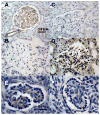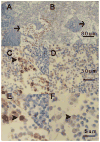Xenotransplantation of pancreatic and kidney primordia-where do we stand?
- PMID: 18992818
- PMCID: PMC2737338
- DOI: 10.1016/j.trim.2008.10.007
Xenotransplantation of pancreatic and kidney primordia-where do we stand?
Abstract
Lack of donor availability limits the number of human donor organs. The need for host immunosuppression complicates transplantation procedures. It is possible to 'grow' new pancreatic tissue or kidneys in situ via xenotransplantation of organ primordia from animal embryos (organogenesis of the endocrine pancreas or kidney). The developing organ attracts its blood supply from the host, enabling the transplantation of pancreas or kidney in 'cellular' form obviating humoral rejection. In the case of pancreas, selective development of endocrine tissue takes place in post-transplantation. In the case of kidney, an anatomically-correct functional organ differentiates in situ. Glucose intolerance can be corrected in formerly diabetic rats and ameliorated in rhesus macaques on the basis of porcine insulin secreted in a glucose-dependent manner by beta cells originating from transplants. Primordia engraft and function after being stored in vitro prior to implantation. If obtained within a 'window' early during embryonic pancreas development, pig pancreatic primordia engraft in non immune suppressed diabetic rats or rhesus macaques. Engraftment of pig renal primordia transplanted directly into rats requires host immune suppression. However, embryonic rat kidneys into which human mesenchymal cells are incorporated into nephronic elements can be transplanted into non-immune suppressed rat hosts. Here we review recent findings germane to xenotransplantation of pancreatic or renal primordia as a novel organ replacement strategy.
Figures




References
-
- Hammerman MR. Organogenesis of endocrine pancreas from transplanted embryonic anlagen. Transplant Immunology. 2004;12(34):249–258. - PubMed
-
- Hammerman MR. Treatment for End-stage Renal Disease: An organogenesis/tissue engineering Odyssey. Transplant Immunology. 2004;12(34):211–218. - PubMed
-
- Hammerman MR. Organogenesis of kidneys following transplantation of renal progenitor cells. Transplant Immunology. 2004;12(34):229–239. - PubMed
-
- Hammerman MR. Windows of opportunity for organogenesis. Transplant Immunology. 2005;15(1):1–8. - PubMed
-
- Brands K, Colvin E, Williams LJ, Wang R, Lock RB, Tuch BE. Reduced immunogenicity of first-trimester human fetal pancreas. Diabetes. 2008;57(3):627–634. - PubMed
Publication types
MeSH terms
Grants and funding
LinkOut - more resources
Full Text Sources
Medical

